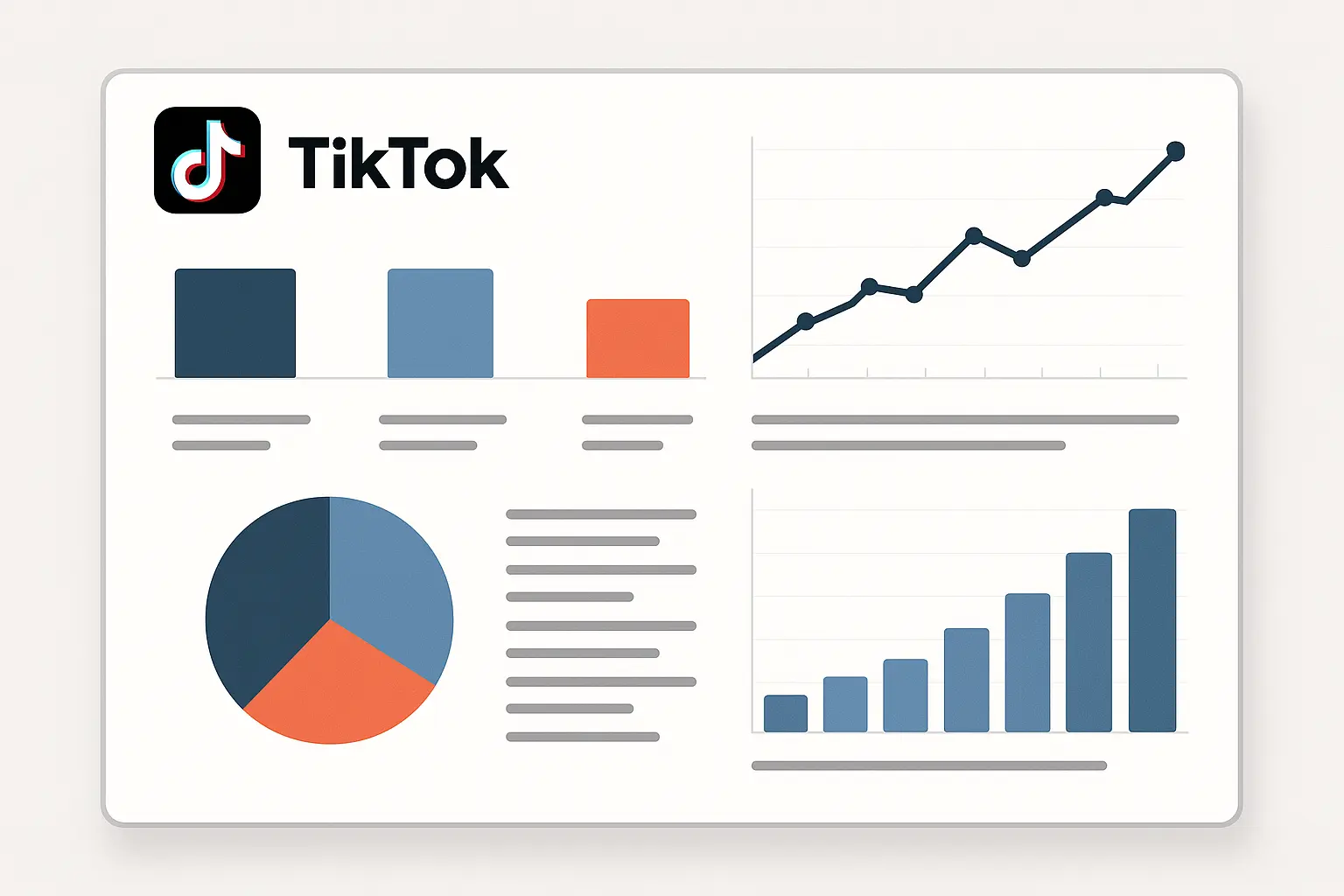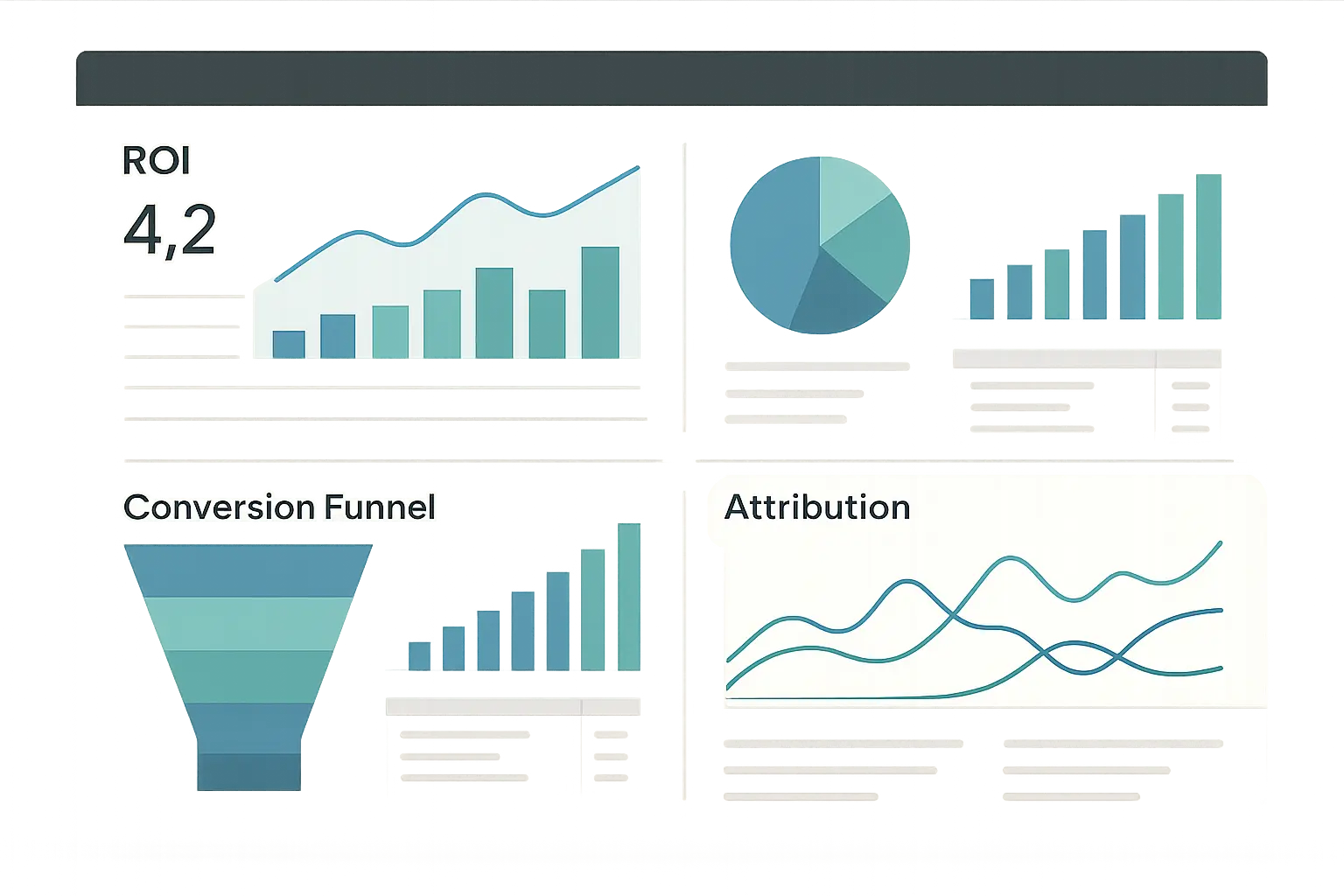Look, I get it – TikTok can feel like throwing money into a black hole sometimes. But here’s the thing: with TikTok’s creator economy generating over $20 billion annually, the brands that figure this out aren’t just getting views – they’re making real money. I’ve spent way too much time (my screen time reports are embarrassing) studying what actually works, and I’m going to share the systematic approaches that consistently turn social media engagement into cash in your bank account.

Table of Contents
-
The Real Reasons TikTok Content Goes Viral (It’s Not What You Think)
-
Brand Success Stories That Actually Changed Everything
-
Simple Frameworks That Work for Any Business
-
How to Track if TikTok Is Actually Making You Money
-
Advanced Tricks Your Competitors Don’t Know About
-
Small Business Wins You Can Copy Tomorrow
-
Real Campaign Examples Worth Your Time
-
Building Something That Lasts on TikTok
-
Final Thoughts
TL;DR
-
Viral TikTok content follows specific patterns – nail the first 3 seconds and you’re halfway there
-
Big brands like Duolingo and Netflix cracked the code by acting human, not corporate
-
Cross-platform content multiplies your ROI when you do it right
-
TikTok rarely converts on first touch – you need proper tracking to see the real impact
-
Small businesses can beat enterprise brands through authentic storytelling
-
AI and AR campaigns are becoming must-haves for serious marketers
-
Long-term success means evolving with the platform while staying true to your brand
The Real Reasons TikTok Content Goes Viral (It’s Not What You Think)
Ever wonder why some videos blow up and yours don’t? After analyzing hundreds of viral campaigns (yes, I have a problem), I’ve discovered that those “spontaneous” viral moments actually follow predictable patterns you can steal.
The Anatomy of Content That Breaks Through
Those first three seconds aren’t just important – they’re everything. You know that feeling when you’re mindlessly scrolling and something makes you actually stop? That’s what we call a pattern interrupt, and it’s not magic – it’s strategy.
Netflix doesn’t waste time with fancy logos because they know you’ll scroll right past. Instead, they jump straight into behind-the-scenes moments that feel like you’re getting secret insider info. Smart, right?
Here’s something that blew my mind when I first realized it: the best TikTok content uses what I call “revelation pacing.” Instead of dumping everything upfront (which is what most businesses do wrong), you reveal information in tiny chunks that keep people hooked. Think of it like breadcrumbs leading to a payoff.
And can we talk about call-to-actions for a second? Most brands slap a “buy now” at the end like an afterthought. The videos that actually convert weave their CTAs naturally into the story. Remember that Ocean Spray viral moment? Nobody told you to buy cranberry juice, but suddenly everyone wanted to recreate that vibe.
Nielsen found that TikTok ads can deliver up to $2.6 in return for every dollar spent – that’s not luck, that’s smart content creation at work. Understanding these performance metrics requires tracking systems similar to our ROAS calculator, which helps you figure out if your advertising is actually working.

Doritos nailed this with their Dinamita campaign – 61 million views because they encouraged creators to make “unhinged confessions” instead of forcing some corporate script. The lesson? Stop trying to control everything and let TikTok be TikTok.
Cracking TikTok’s Algorithm Code
Okay, let’s talk about the algorithm – that mysterious force that seems to hate your content (but doesn’t, I promise). Here’s the thing: TikTok rewards speed more than anything else. If your video gets engagement in the first hour, you’re golden. If it doesn’t, well… better luck next time.
I’ve seen brands obsess over hashtags, using all 30 like it’s some kind of SEO hack. Wrong move. Three to five strategic hashtags beat 30 random ones every single time. It’s about being discoverable in the right circles, not casting the widest net possible.
Want to know what really gets the algorithm’s attention? Controversy. Not the “get you canceled” kind, but the “this might be an unpopular opinion” kind. Videos that spark genuine discussion (not just heart emojis) get pushed harder than safe, boring content.
Here’s my algorithm cheat sheet:
-
Post when your people are actually online (not when it’s convenient for you)
-
Use hashtags like a sniper, not a shotgun
-
Ask questions that people actually want to answer
-
Hook them in three seconds or lose them forever
-
Reply to comments fast – within two hours if possible
-
Create content worth arguing about (nicely)
Maximizing Content ROI Across Platforms
Listen, if you’re only posting your TikTok on TikTok, you’re leaving money on the table. But here’s where most people mess up – they just copy and paste the same video everywhere. That’s like wearing a tuxedo to the beach.
Each platform has its own vibe. Instagram Reels wants things a bit more polished. YouTube Shorts expects more context. Twitter (sorry, X) wants the highlight reel. The smart move? Create for TikTok first, then adapt.
I worked with a client who turned one viral TikTok into five different pieces of content: the original video, an Instagram carousel breaking down the tips, a YouTube Short with extra context, a Twitter thread, and an email newsletter. One piece of content, five different audiences reached.
|
Platform |
Sweet Spot |
What’s Different |
How to Adapt |
|---|---|---|---|
|
TikTok |
15-60 seconds |
Raw, authentic, trend-focused |
Your original content |
|
Instagram Reels |
15-30 seconds |
More polished, branded |
Add graphics, clean it up |
|
YouTube Shorts |
30-60 seconds |
Educational angle preferred |
Include more context |
|
Twitter/X |
2-10 seconds |
News-worthy moments |
Extract the best 10 seconds |
Brand Success Stories That Actually Changed Everything
You want to know what’s wild? Some of the biggest brands on TikTok succeeded by basically throwing their corporate playbook out the window. These aren’t your typical case studies – they’re more like “how to stop being boring and start being human.”
How Corporate Giants Became TikTok Natives
Duolingo’s transformation still amazes me. They took their green owl mascot and gave it a personality disorder (in the best way possible). This thing has beef with other brands, makes self-deprecating jokes about its own app, and participates in trends that have absolutely nothing to do with language learning.
The genius part? They understood that TikTok doesn’t reward perfection – it rewards personality. Instead of polished ads about learning Spanish, they made content about the universal struggle of ignoring Duolingo notifications. Suddenly, everyone was relating to an app mascot.
Netflix cracked the code differently. They realized people are obsessed with behind-the-scenes content, so they started sharing bloopers, cast interviews, and production secrets that traditional marketing would never touch. It’s like they’re letting you peek behind the curtain, and people eat that stuff up.
Then there’s Ocean Spray. That viral moment with Nathan Apodaca wasn’t planned, but their response was brilliant. Instead of trying to control the narrative or make it “brand appropriate,” they leaned in, sent the guy a truck, and created follow-up content that felt genuine.
Recent political drama around TikTok actually made brands more popular on the platform – The Harris Poll found that “TikTok’s positive brand momentum soared as the day of the shutdown neared”. Sometimes controversy creates connection.

Building Authentic Influencer Partnerships
Here’s where most brands mess up influencer partnerships: they focus on follower counts instead of actual engagement. I’ve seen micro-influencers with 10K followers outperform mega-influencers with millions because their audiences actually care about what they’re saying.
The partnerships that work give creators freedom within guidelines. You provide the key messages and product info, then trust them to present it authentically. Over-script it, and you’ll get content that feels like a hostage video.
Stop obsessing over view counts. Comments that show genuine interest, saves for later, and shares to close friends – that’s where the real value lives. It’s like the difference between a stadium full of people politely clapping and a small room full of people actually listening.
Dremel figured this out with their Blueprint tool campaign. Instead of going after the biggest names, they found creators genuinely associated with “beginner,” “homeowner,” and “DIY.” Result? 10.5 million views and 1200% increase in social traffic. That’s what happens when you match the right message with the right audience.
Simple Frameworks That Work for Any Business
Okay, let’s get into the nuts and bolts. I’ve tested these frameworks with dozens of brands, from local restaurants to Fortune 500 companies, and the principles hold up across the board. The key is having a system instead of just throwing content at the wall and hoping something sticks.
Building Campaign Architecture That Delivers
Forget demographics for a minute. On TikTok, psychographics matter more – why do people engage with certain content types? What emotional triggers make them stop scrolling? Understanding this helps you create videos that hit differently.
I always tell clients to follow the 80/20 rule: 80% pure entertainment or value, 20% brand stuff. The moment you flip that ratio, your audience checks out. They’re not on TikTok to be sold to – they’re there to be entertained, educated, or inspired.
Your content calendar needs to be flexible. Plan your pillars and key messages, sure, but leave room to jump on trends or respond to current events. The brands that can pivot quickly while staying true to their core message? Those are the ones that win.

Tracking Performance That Actually Matters
Here’s the truth nobody talks about: TikTok rarely converts on first touch. Someone discovers your brand on TikTok, researches you on Google, maybe signs up for your email list, then buys three weeks later. If you’re only tracking direct TikTok conversions, you’re missing the bigger picture.
Multi-touch attribution is crucial, but it’s also complicated. You need UTM parameters, pixel tracking, and sometimes good old-fashioned customer surveys to understand the full impact. It’s messy, but it’s the only way to know if TikTok is actually working for your business.
Industry benchmarks matter too. E-commerce brands focus on cost-per-acquisition, B2B companies care about lead quality and sales cycle impact. Don’t optimize for vanity metrics just because they look good in reports.
With 55% of TikTok users buying products they see advertised and 50% purchasing from TikTok Lives according to InBeat Agency research, proper tracking becomes essential. Our TikTok engagement rate calculator helps you evaluate whether your content is actually connecting with people.
Industry-Specific Success Patterns
E-commerce on TikTok isn’t about product catalogs – it’s about transformation stories. Show the before and after. Solve a problem. Make people’s lives better in 60 seconds or less. The most successful e-commerce TikToks feel like helpful tips that happen to feature products.
B2B companies? Stop trying to make enterprise software sexy. Instead, show the humans behind the business. Share workplace culture, industry insights, and the real challenges your team faces. People buy from people, even in B2B.
Service-based businesses crush it on TikTok by demonstrating expertise through quick tips and before-and-after reveals. You’re not selling services directly – you’re positioning yourself as the go-to expert in your field.
|
Industry |
What Actually Matters |
Content That Works |
How to Measure Success |
|---|---|---|---|
|
E-commerce |
Sales attribution, quality traffic |
Product demos, transformation stories |
Actual revenue, not just clicks |
|
B2B SaaS |
Lead quality, sales impact |
Workplace culture, industry insights |
Demo requests, qualified leads |
|
Professional Services |
Authority, brand awareness |
Quick tips, expertise demos |
Consultation bookings, referrals |
|
CPG/Food |
Brand recall, purchase intent |
Recipe content, lifestyle integration |
Store locator usage, brand searches |
How to Track if TikTok Is Actually Making You Money
I’ve worked with brands that were ready to quit TikTok because they thought it wasn’t working. Then we set up proper attribution tracking and discovered TikTok was actually their highest-performing channel. The problem wasn’t the platform – it was the measurement.
Setting Up Analytics That Tell the Truth
Most brands make the mistake of only looking at direct conversions. Someone sees your TikTok, doesn’t buy immediately, researches you on Google, signs up for your email list, then purchases two weeks later. If you ‘re only crediting the email campaign, you’re missing TikTok’s role in starting that journey.
You need tracking that captures the whole customer journey – from first TikTok view to final purchase. This means implementing pixels, UTM parameters, and customer journey mapping. It’s more complex than looking at TikTok’s native analytics, but it’s the only way to get accurate data.
Industry benchmarks help you know if you’re winning or losing. A restaurant’s success metrics look completely different from a SaaS company’s. Understanding what “good” looks like in your industry prevents you from celebrating vanity metrics while ignoring real business impact.

Optimizing Budget Allocation for Maximum Impact
Here’s what I’ve learned about TikTok budgets: many brands get better ROI from consistent organic content than paid promotion. The key is understanding your audience well enough to create content they actually want to engage with.
My general recommendation for budget allocation: 60% content creation, 25% paid amplification, 15% influencer collaborations. But this varies based on your industry and objectives. A local restaurant might go 80% organic, while a national e-commerce brand might flip those percentages.
When you find content that works, create systems to produce more of it consistently. Don’t try to recreate viral lightning in a bottle – build frameworks for consistent performance instead.
Our marketing budget calculator helps you figure out optimal spend across different channels, including TikTok.
Budget optimization checklist:
-
Track cost-per-engagement across all channels
-
Compare organic reach vs. paid performance
-
Adjust allocation based on actual attribution data
-
Keep emergency budget for trending opportunities
-
Test different content-to-promotion ratios
-
Monitor competitor spending patterns
-
Focus budget on content themes that convert
Managing Risks and Staying Compliant
TikTok’s policies change frequently, and violations can tank your reach overnight. You need approval processes that protect you from policy violations while still allowing creative freedom. It’s a delicate balance.
The recent regulatory discussions around TikTok highlight why platform diversification matters. As ProMarket analysis shows, “conflicts between political goals of national security, freedom of speech, and competition policy” demonstrate the complex landscape brands must navigate.
Risk management isn’t just about compliance – it’s about building sustainable growth that doesn’t depend entirely on one platform’s success.
Advanced Tricks Your Competitors Don’t Know About
While your competitors are still figuring out basic posting schedules, early adopters are leveraging AI-powered content creation, AR campaigns, and live commerce features to stay ahead. These aren’t experimental tactics anymore – they’re becoming must-haves for serious TikTok marketing.
Leveraging Emerging Technology
AI tools for TikTok aren’t about replacing creativity – they’re about scaling it. Use AI for caption writing, basic editing, and trend prediction, then focus your human energy on strategy and storytelling. The brands winning with AI are using it to enhance human creativity, not replace it.
Trend prediction algorithms help you jump on emerging trends before they peak. Being first to market with trend adoption can significantly boost your organic reach. The key is having systems in place to act quickly when opportunities arise.
AR campaigns are proving incredibly effective – Smashbox achieved a 50% engagement rate within 10 days of launching their AR campaign, according to InBeat Agency data. The most successful AR filters solve real problems or help users create better content.

Creating Immersive Brand Experiences
The AR filters that go viral provide genuine value to users. They help people create better selfies, express their personality, or participate in cultural moments. The best branded effects don’t feel like ads – they feel like useful tools.
Live commerce through TikTok Live Shopping creates interactive buying experiences that drive immediate sales. The successful live commerce sessions combine entertainment with product demonstrations and limited-time offers. It’s QVC for the TikTok generation.
Advanced Audience Targeting
Behavioral targeting goes beyond basic demographics to focus on user actions and engagement patterns. This granular targeting improves both ad performance and organic content relevance.
Lookalike audiences use your best customers’ TikTok behavior to find similar users. This works particularly well for e-commerce and lead generation campaigns where you have clear conversion data to work with.
Custom audiences let you retarget website visitors and email subscribers with TikTok-specific content that moves them further down your sales funnel.
Small Business Wins You Can Copy Tomorrow
Here’s what I love about TikTok: small businesses can outperform Fortune 500 companies by being more authentic, agile, and responsive. I’ve watched local restaurants get more engagement than national chains because they embraced their constraints and turned limitations into creative advantages.
Local Business Viral Success Stories
Restaurants that go viral usually do it by showing food prep, sharing customer reactions, or revealing menu secrets. These authentic moments resonate way more than polished promotional videos and can drive serious foot traffic.
I know a bakery owner who started filming her 4 AM bread-making routine. No fancy equipment, just her phone propped up while she worked. Those videos regularly hit 100K+ views because people are fascinated by the behind-the-scenes process.
Retail stores succeed by making shopping feel like treasure hunting. Show product discovery, styling tips, or behind-the-scenes content that makes viewers feel like they’re getting insider access to the best stuff.
Service providers win by demonstrating expertise through quick tips and transformation reveals. A local landscaper I work with films 30-second before-and-after yard transformations. He books clients directly from those videos because people can see exactly what he’s capable of.

Bootstrap Marketing Strategies That Work
Low-budget doesn’t mean low-impact. Some of the most successful TikTok campaigns I’ve seen cost nothing but time and creativity. User-generated content campaigns, employee advocacy, and community challenges can generate massive engagement without ad spend.
Creative constraints often lead to better content. When you can’t rely on big budgets or fancy equipment, you’re forced to focus on storytelling and authenticity – which is exactly what TikTok rewards.
Community building is where small businesses have a huge advantage. You can respond to every comment, engage with followers personally, and make people feel valued in ways that big brands simply can’t scale.
Buddig’s seasonal campaign with 18 family and foodie creators generated 377,000 organic impressions and 5.5 million paid impressions by focusing on real meal prep scenarios instead of generic product shots. Small-scale, authentic campaigns can achieve significant reach.
Competing with Enterprise Brands
Your superpower as a small business? Speed and authenticity. While big brands navigate approval processes, you can jump on trends immediately and respond to customer feedback in real-time.
Niche expertise gives you advantages over generalist competitors. Deep knowledge of specific customer segments or specialized products allows for more targeted, relevant content that hits harder with your ideal customers.
Personal branding is your secret weapon. When you become the face of your company, you create stronger emotional connections than faceless corporate brands ever could. People buy from people they know, like, and trust.
Small Business TikTok Success Checklist:
-
Find your unique angle or local advantage
-
Show behind-the-scenes content regularly (people love this stuff)
-
Respond to every comment like your business depends on it (because it does)
-
Partner with local micro-influencers and happy customers
-
Jump on trends fast – no committee meetings required
-
Share real customer stories and testimonials
-
Teach something useful in every video
Real Campaign Examples Worth Your Time
I’ve built a database of successful TikTok campaigns that actually moved the needle for businesses. These aren’t just viral moments – they’re campaigns that generated real revenue, leads, and brand awareness. Here’s what worked and why.
B2B TikTok Success Models
Companies like Slack, HubSpot, and Adobe figured out that B2B TikTok isn’t about making enterprise software look cool (spoiler: it’s not). Instead, they focused on workplace culture, industry insights, and the humans behind the technology.
Professional service firms use TikTok to demonstrate expertise through quick tips and industry commentary. The key is providing immediate value while subtly showcasing what you’re capable of. No one wants a sales pitch disguised as a tip.
Software companies that succeed focus on solving common user problems and sharing productivity hacks. They help their audience succeed rather than just promoting features nobody asked about.

Seasonal Campaign Templates
Holiday campaigns that work tap into cultural moments and seasonal emotions rather than just pushing sales. The most successful seasonal content feels native to TikTok while naturally incorporating brand messaging.
Event-driven campaigns capitalize on trending topics and current events to insert brands into relevant conversations. Timing and authenticity are everything – try to force it and you’ll look desperate.
Back-to-school, summer, and holiday campaigns that perform well provide genuine value related to the season while subtly weaving in product placement. Focus on helping users navigate seasonal challenges first, selling second.
Crisis Management Case Studies
Brands that successfully navigate negative feedback respond quickly, authentically, and with appropriate humor when it fits. The key is acknowledging issues without getting defensive while showing genuine commitment to doing better.
Algorithm changes hit everyone, but brands with diversified content strategies survive better. Don’t put all your eggs in one content format basket – when TikTok changes the rules, you need backup plans.
PR challenges require transparent communication and real accountability. Brands that try to hide or deflect criticism face way more backlash than those who address issues head-on with authentic responses.
Hashtag Challenge Success Frameworks
Branded hashtag challenges that generate millions of submissions provide clear instructions, achievable goals, and genuine entertainment value. The best challenges feel like games, not marketing campaigns.
User-generated content campaigns succeed when they tap into existing behaviors rather than asking people to do something completely new. The most viral challenges enhance or gamify activities people already enjoy.
Challenge promotion involves seeding content with influencers, providing clear examples, and maintaining momentum through featured content and prizes. Even “organic” viral challenges usually have strategic planning behind them.

Building Something That Lasts on TikTok
Here’s what I’ve learned from watching brands rise and fall on TikTok: viral moments don’t build businesses, but sustainable strategies do. The brands still thriving years later adapted their approach as the platform matured while maintaining what made them authentic in the first place.
Content Evolution Strategies
Platform maturity changes everything. What worked in TikTok’s early days feels outdated now because users expect higher production values, more sophisticated storytelling, and deeper value from content.
You need to balance consistency with innovation. Your brand voice should stay recognizable while your content formats, topics, and presentation styles evolve with platform trends and audience preferences. Get stuck repeating old formulas and watch your engagement slowly die.
Your audience tells you exactly what they want through comments, engagement patterns, and DMs. Treat your TikTok analytics like a continuous feedback loop for content improvement. The data doesn’t lie, even when it hurts.
Long-term success requires documented processes for trend adoption, content approval, and performance evaluation. This prevents your TikTok strategy from being too dependent on one person while maintaining the agility needed for platform success.

Team Structure and Resource Allocation
Organizational frameworks for TikTok marketing need clear roles and responsibilities that don’t slow down content creation. The most successful teams balance creative freedom with brand consistency through well-defined guidelines, not rigid approval chains.
Content creation workflows must account for TikTok’s fast pace while maintaining quality standards. This might mean pre-approved content themes, streamlined editing processes, and clear escalation procedures for time-sensitive opportunities.
Resource allocation needs flexibility to capitalize on viral moments while maintaining consistent content production. Smart brands allocate budget for both planned content and opportunistic trend participation.
Team training ensures everyone understands TikTok culture, platform best practices, and brand guidelines. Regular updates help teams stay current with platform changes and emerging trends.
Cross-functional collaboration between marketing, creative, and customer service creates more authentic, responsive content. Customer service insights inform content topics while creative teams ensure brand consistency.
How The Marketing Agency Can Transform Your TikTok Strategy
Look, most businesses struggle with TikTok because they’re treating it like Facebook or Instagram, chasing vanity metrics without connecting engagement to actual revenue. We solve this by focusing on performance that directly impacts your bottom line.
Our approach starts with comprehensive market analysis and behavioral insights to ensure your content resonates with your actual customers, not just whatever’s trending. We understand that successful TikTok marketing requires sophisticated attribution modeling to track the journey from discovery to conversion.
We integrate your TikTok strategy with SEO, PPC, and email marketing efforts, creating compound growth effects that standalone social campaigns can’t achieve. Our AI-driven analytics continuously adapt your strategy in real-time, optimizing performance and ad spend based on actual data, not guesswork.
Ready to stop experimenting and start seeing real results from TikTok? Our proven framework turns social media engagement into measurable business growth. Let’s talk about what’s actually possible for your business – schedule a consultation today.
Final Thoughts
TikTok marketing isn’t about dance videos and viral moments anymore. The brands building sustainable success treat it like any other serious marketing channel – with clear objectives, deep audience understanding, rigorous performance measurement, and continuous optimization.
Everything we’ve covered here reveals that TikTok success isn’t random luck. Viral content follows predictable patterns, successful brands adapt their voice while staying authentic, and real ROI comes from tracking the full customer journey, not just direct conversions.
Your TikTok strategy should evolve with the platform while staying true to your brand values and business objectives . Focus on providing genuine value, measure what actually matters for your business, and remember that sustainable success comes from consistent execution, not hoping lightning strikes twice.
The brands that will dominate TikTok moving forward are those that master the balance between creativity and strategy, authenticity and measurement, trend participation and brand consistency. Start implementing these frameworks today, and you’ll be miles ahead of competitors still trying to figure out why their videos aren’t getting views.



